If you’re anything like me, there’s nothing more pleasing than a cupboard full of pretty, matching glass jars filled with food. That minimalist kitchen design look is so popular right now and it’s hard not to want to go out and splurge on a matching set of storage containers! Those containers can be so expensive though!
Plus, so much of our food comes packaged in glass or plastic jars already. Instead of recycling them, why not take the labels off your jars and reuse them!? Saving money and the environment is a win-win!
Once the label is off cleanly, you can even add new labels to the jars to keep your food organized and add a pretty, matching aesthetic.
That’s why I figured out how to remove labels from jars so I can reuse them!
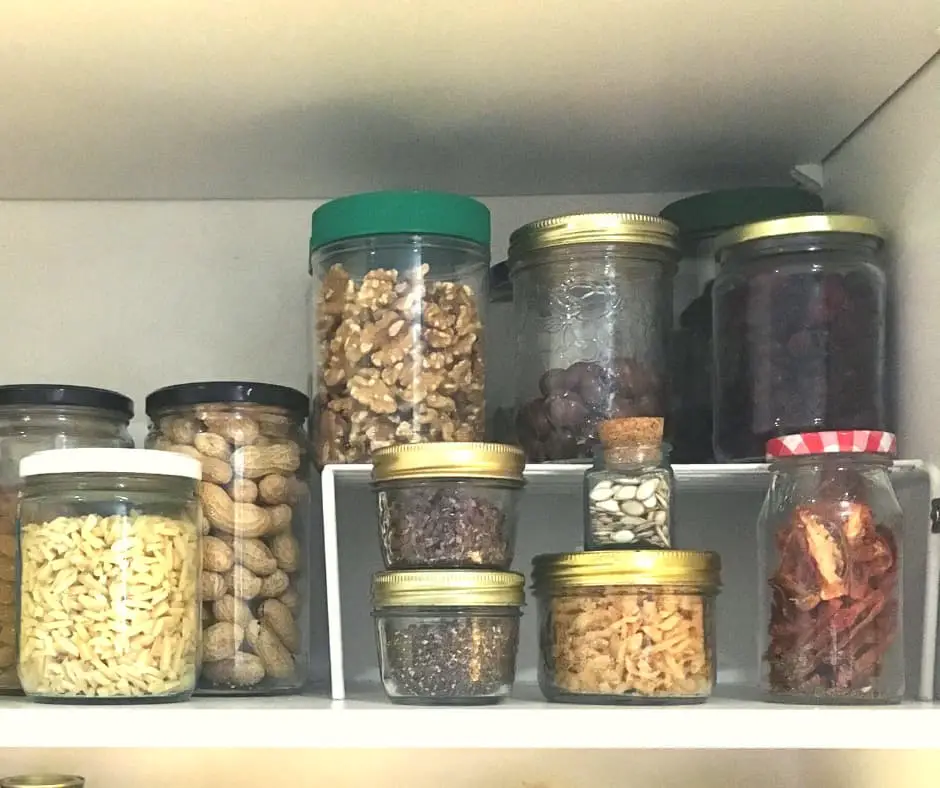
Let me preface this by saying not all jars are created equal.
I prefer wide mouth jars with straight sides. They’re easier to clean and refill. They also take up less space while holding more than jars with rounded sides.
I also prefer jars with plain lids (not printed). This is mostly aesthetic, but also handy if you need to label the lid for anything.
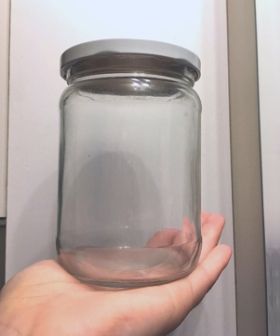
Also, I only save jars made of clear glass or plastic. I’m a super visual person so if my food is in a jar, I want to be able to see it!
Plus, I noticed we have a lot more wasted food come out of opaque containers, like yogurt tubs, rather than clear containers!
So this whole process actually starts way before having an empty food jar. I start it at the grocery store when I’m making my purchasing decisions.
My first choice is always unpackaged whenever possible (and affordable).
If there’s no package free option, I’ll choose the product with a good reusable container or compostable packaging within my price range. I prefer glass jars over plastic.
If none of these options are available or affordable, I might consider getting the option with recyclable packaging, or I might skip it all together.
I try to avoid products in non-reusable, non-compostable or non-recyclable packaging all together whenever possible.
This page contains affiliate links which means I may earn a commission if you use them, at no additional cost to you. See disclosure policy for details.
How to Get Labels off Jars
Now that you have some jars and have used up what’s inside, take a few steps to remove the sticky label from the jars so you can reuse them.
A quick internet search comes up with a lot of ways to do this. A common suggestion is to use Goo Gone or acetone.
I don’t use these methods because I don’t like to use harsh chemical products like that. Plus, I’m on a budget!
I use inexpensive, non-toxic ingredients I have on hand at all times, and multipurpose tools like this 2-in-1 scraper (keep reading to see how I use it to remove the labels from jars!)

I’ve listed step-by-step how I remove labels from glass jars and from plastic jars. The steps are very similar, however there are different types of labels and some tools you can’t use on plastic without wrecking the container itself.
If you’re lucky, you can cut the paper label off easily and there will only be a few dots of glue to get off.
Usually though, you will have to soak the labels in hot soapy water first. I simply soak them while I’m doing other dishes, to avoid wasting water and dish soap just on getting the labels off the jars.
After soaking, sometimes the labels come off almost entirely in one piece. I think these ones must use a water soluble glue.
Other times, the label is stubborn and only peels off the jar in tiny strips and a layer of paper backing is left behind. If there’s still paper left behind, soak again.

6 Steps to Remove Labels from Jars Safely & Easily
Time needed: 15 minutes.
Get the labels and sticky glue off jars with these simple steps. Repeat any of the steps until you have a clean, smooth jar with no label or sticky glue residue!
- Soak.
Soak the jar in hot water for at least 10 minutes.
- Peel off the label.
This step is about getting the paper part of the label off. Sometimes the whole label comes right off in one piece! If it doesn’t come off right away, or you can only get some of it off, let it soak longer.
- Scrape off paper residue. (Skip this step if the label came off in one piece.)
If the paper residue is still dry after you peeled off the top layer of the label, soak the jar again to soften the paper.
Use a scraper tool like this to scrape any paper left from the label. Once that’s all gone you’ll probably have some sticky residue left. - Add oil.
Rub a few drops of oil over the sticky parts to remove the sticky label from your glass jar.
Let it sit for at least 10 minutes (I use canola oil or leftover cooking oil).
After it has sat, the oil should have softened the glue.
Rub the oil/glue mixture around with your fingers to make sure it’s loosened. If it hasn’t loosened yet, let it sit longer. - Scrape off sticky residue.
Scrape the loosened glue off with the scraper tool. I recommend using a plastic scraper tool so you don’t ruin a butter knife or risk cutting yourself with a razor blade.
- Wash the jar.
Wash the jar with soap and water to remove the oil.
If there is still glue residue left, add more oil, rub it in, let it sit, then scrape it off and wash again.
It might seem like it takes a lot of time or effort to get the labels off jars, but most of the time is just letting the jar sit. I usually put the jar in the dish water when I do dishes and let it soak. This way it’s just like another dish to wash and doesn’t really add much extra time.

How to Remove Labels from Glass Jars:
The steps listed above are what I usually follow and it works great! If you have a particularly stubborn label or just want to try getting it done faster, there are a couple other things you can try to remove labels from glass jars.
To make the process of removing labels from glass jars a bit faster or easier, try these tips:
- Boiling water: after soaking the glass jar, pour boiling water into it and let it sit for a few more minutes. The boiling water helps soften the glue even more and it should come off more easily.
- Razor blade: try using a razor blade to scrape the glue off after it has soaked in oil. Because it’s so sharp, the razor blade should get the glue off faster than a dull knife. Just be careful not to cut yourself! This is a really good tool that holds the razor blade and allows you to scrape safely. It even comes with a plastic razor blade which would be perfect for this job!
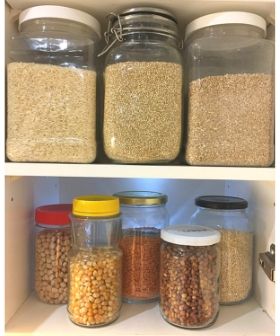
How to Remove Labels from Plastic Jars
Removing labels from plastic jars is a bit more of a challenge as plastic is less durable than glass. You can’t use boiling water as it might warp the plastic. You can’t use a metal razor blade or dull knife as they might scratch the surface of the plastic jar.
Here’s what to try instead:
- Plastic razor blade: Using a plastic razor blade, like in this tool, will help you scrape off the sticky label residue from plastic containers without damaging the plastic.
- Baking soda: after rubbing oil on the plastic jar and letting it sit for a bit, make a paste of baking soda and oil. Rub the paste onto the sticky label until it comes off. The baking soda acts as a mild abrasive that helps scrape the glue off, but doesn’t harm the plastic
Read these other handy uses for baking soda in the kitchen
Some additional tips for removing sticky labels from jars:
- Don’t use a sponge, dish cloth or scrubby. The glue will gum it up and potentially ruin it.
- Don’t use the blade of a sharp knife. You might dull or damage the blade and risk cutting yourself.
- Don’t use harsh cleaners. Who knows what’s in them and if they’re even safe to use. I try and avoid them whenever possible.
- Don’t leave the sticky residue on. It will collect dirt and germs; not things you want in your food storage containers! If you can’t get the glue off, it’s probably better to just recycle the jar.
The Jar Collection Conundrum
After saving jars for a while, you get to a point where you probably don’t need any more jars. G has said to me a few times “don’t we have enough jars?” ? Yes and no, love.
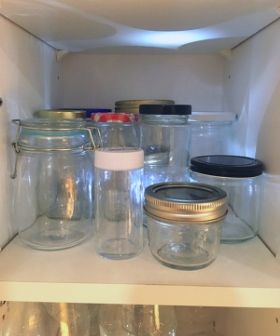
Once you see how simple it is to get nice, clean jars, you might want to start storing more and more things in them!
The point of “too many jars” is up to you. Where do you lie in the frugality vs minimalism vs zero waste spectrum?
If you’re super frugal, you’ll probably have more jars than a minimalist.
If you’re more minimalist, you might have fewer jars, but might begin replacing jars with only your favorite type of jars so they’ll all eventually match.
If you’re more focused on zero waste, you might have less of an issue collecting too many if you buy mostly in bulk. But since buying in bulk is not possible for everyone, you might opt only for food packaged in glass jars. Glass is able to be recycled indefinitely, while plastic can only be downcycled a few times before it can no longer be reused and is designed for trash.
If you accumulate more than you need or want, try sharing with friends or on a trading site like BUNZ. You can sign up HERE.
Recycling is ok, but reducing and reusing are definitely better options for the environment.
In the end, if you just want to buy a matching set of small mason jars for your spices or whatever, that’s perfectly ok too!
I want to know: have you tried this easy way to remove labels from jars? How did it work for you? Do you have any other tips?
Keep Reading:
21 Uses for Arm & Hammer Baking Soda
Cute Kitchen Pantry Labels
Frugal Minimalist Kitchen List
Frugal Minimalist Pantry Staples
How to Stock a Pantry for the First Time (On a Budget)
How to Get Motivated to Clean When Overwhelmed by Mess


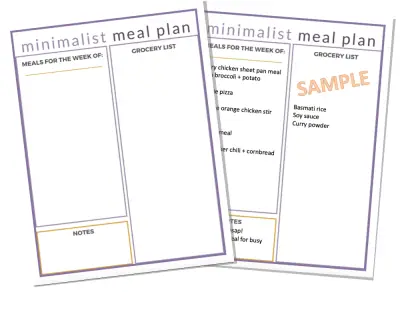
This worked perfectly, thank you! Took 20 minutes of soaking and then the labels and glue came off. I have tried this a thousand times in the past, but what I didn’t know to do was add oil! Any success I’ve had has been partially due to easy-off labels. I can’t be stopped now! Lol
lol great I’m so glad you found it helpful! Enjoy using all the jars!
I use Eucalyptus Oil with stainless steel scourer after the jars have soaked and labels have mostly come off, and have dried a bit, to gently scrub the glue off the jars.
Thanks for the tip!
But what about when we get all of our food shopping home? What then? Is it possible to store food without plastic?
Having lots of jars is a helpful way to store food without plastic!